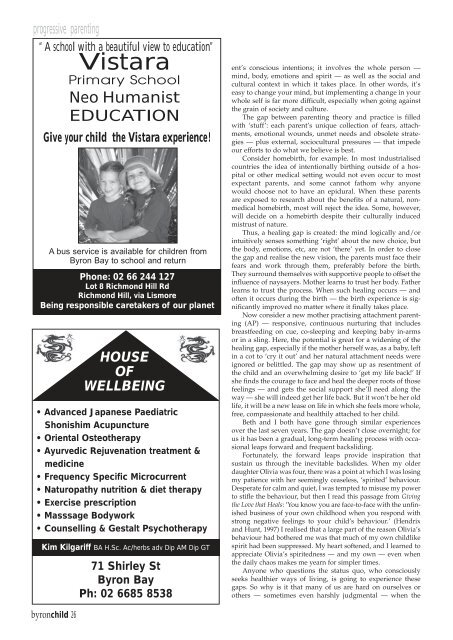byronchild - logo
byronchild - logo
byronchild - logo
You also want an ePaper? Increase the reach of your titles
YUMPU automatically turns print PDFs into web optimized ePapers that Google loves.
progressive parenting<br />
“ A school with a beautiful view to education”<br />
<strong>byronchild</strong> 26<br />
Vistara<br />
Primary School<br />
Neo Humanist<br />
EDUCATION<br />
Give your child the Vistara experience!<br />
A bus service is available for children from<br />
Byron Bay to school and return<br />
Phone: 02 66 244 127<br />
Lot 8 Richmond Hill Rd<br />
Richmond Hill, via Lismore<br />
Being responsible caretakers of our planet<br />
HOUSE<br />
OF<br />
WELLBEING<br />
Advanced Japanese Paediatric<br />
Shonishim Acupuncture<br />
Oriental Osteotherapy<br />
Ayurvedic Rejuvenation treatment &<br />
medicine<br />
Frequency Specific Microcurrent<br />
Naturopathy nutrition & diet therapy<br />
Exercise prescription<br />
Masssage Bodywork<br />
Counselling & Gestalt Psychotherapy<br />
Kim Kilgariff BA H.Sc. Ac/herbs adv Dip AM Dip GT<br />
71 Shirley St<br />
Byron Bay<br />
Ph: 02 6685 8538<br />
ent’s conscious intentions; it involves the whole person —<br />
mind, body, emotions and spirit — as well as the social and<br />
cultural context in which it takes place. In other words, it’s<br />
easy to change your mind, but implementing a change in your<br />
whole self is far more difficult, especially when going against<br />
the grain of society and culture.<br />
The gap between parenting theory and practice is filled<br />
with ‘stuff’: each parent’s unique collection of fears, attachments,<br />
emotional wounds, unmet needs and obsolete strategies<br />
— plus external, sociocultural pressures — that impede<br />
our efforts to do what we believe is best.<br />
Consider homebirth, for example. In most industrialised<br />
countries the idea of intentionally birthing outside of a hospital<br />
or other medical setting would not even occur to most<br />
expectant parents, and some cannot fathom why anyone<br />
would choose not to have an epidural. When these parents<br />
are exposed to research about the benefits of a natural, nonmedical<br />
homebirth, most will reject the idea. Some, however,<br />
will decide on a homebirth despite their culturally induced<br />
mistrust of nature.<br />
Thus, a healing gap is created: the mind logically and/or<br />
intuitively senses something ‘right’ about the new choice, but<br />
the body, emotions, etc, are not ‘there’ yet. In order to close<br />
the gap and realise the new vision, the parents must face their<br />
fears and work through them, preferably before the birth.<br />
They surround themselves with supportive people to offset the<br />
influence of naysayers. Mother learns to trust her body. Father<br />
learns to trust the process. When such healing occurs — and<br />
often it occurs during the birth — the birth experience is significantly<br />
improved no matter where it finally takes place.<br />
Now consider a new mother practising attachment parenting<br />
(AP) — responsive, continuous nurturing that includes<br />
breastfeeding on cue, co-sleeping and keeping baby in-arms<br />
or in a sling. Here, the potential is great for a widening of the<br />
healing gap, especially if the mother herself was, as a baby, left<br />
in a cot to ‘cry it out’ and her natural attachment needs were<br />
ignored or belittled. The gap may show up as resentment of<br />
the child and an overwhelming desire to ‘get my life back!’ If<br />
she finds the courage to face and heal the deeper roots of those<br />
feelings — and gets the social support she’ll need along the<br />
way — she will indeed get her life back. But it won’t be her old<br />
life, it will be a new lease on life in which she feels more whole,<br />
free, compassionate and healthily attached to her child.<br />
Beth and I both have gone through similar experiences<br />
over the last seven years. The gap doesn’t close overnight; for<br />
us it has been a gradual, long-term healing process with occasional<br />
leaps forward and frequent backsliding.<br />
Fortunately, the forward leaps provide inspiration that<br />
sustain us through the inevitable backslides. When my older<br />
daughter Olivia was four, there was a point at which I was losing<br />
my patience with her seemingly ceaseless, ‘spirited’ behaviour.<br />
Desperate for calm and quiet, I was tempted to misuse my power<br />
to stifle the behaviour, but then I read this passage from Giving<br />
the Love that Heals: ‘You know you are face-to-face with the unfinished<br />
business of your own childhood when you respond with<br />
strong negative feelings to your child’s behaviour.’ (Hendrix<br />
and Hunt, 1997) I realised that a large part of the reason Olivia’s<br />
behaviour had bothered me was that much of my own childlike<br />
spirit had been suppressed. My heart softened, and I learned to<br />
appreciate Olivia’s spiritedness — and my own — even when<br />
the daily chaos makes me yearn for simpler times.<br />
Anyone who questions the status quo, who consciously<br />
seeks healthier ways of living, is going to experience these<br />
gaps. So why is it that many of us are hard on ourselves or<br />
others — sometimes even harshly judgmental — when the


